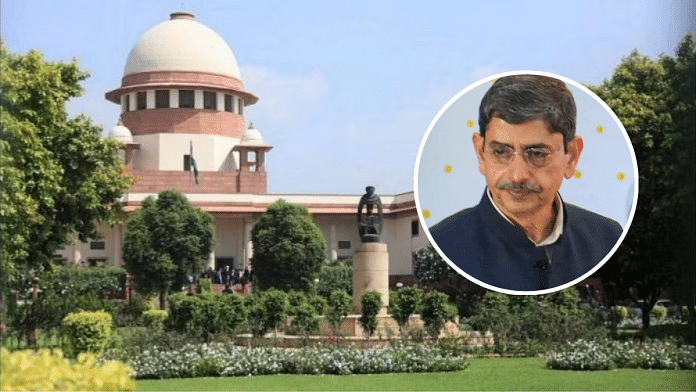Between January 2020 and April 2023, the Tamil Nadu Legislative Assembly passed twelve bills—mostly related to state universities and appointment of Vice Chancellors. These were sent to the governor, only to languish without response. After the state approached the Supreme Court in 2023, the governor reacted—rejecting some bills and reserving others for the President. The Assembly then re-passed ten of them, which were once again reserved for presidential consideration. The state government turned to the judiciary for relief. The Supreme Court stepped in—and gave a solution.
But that solution has now led to a storm, if not a tornado, in the legal and political corridors.
When the court writes what the Constitution doesn’t
At the heart of the controversy is the concept of “deemed assent.” Under the Constitution, Article 200 outlines the governor’s limited but clear roles: to grant assent, withhold assent, return the bill for reconsideration, or reserve it for the President. Nowhere does it provide for inaction leading to automatic assent.
By introducing such a mechanism, the court crossed a line—from interpretation into invention. It attempted to plug an institutional gap, but did so without the authority to amend the Constitution. Under Article 368, only Parliament wields that power.
The court’s intentions may well have been noble. But noble intentions cannot override constitutional procedure. While it may be tempting to applaud swift judicial action in the face of political dysfunction, we must be cautious about the precedent it sets—that courts can unilaterally reshape constitutional duties when other institutions fall short.
Procedural lapses and ignored precedents
The legal flaws are as troubling as the constitutional ones. First, the verdict was delivered by a two-judge bench, even though Article 145(3) clearly requires that any case involving substantial constitutional interpretation be heard by a Constitution Bench of five or more judges. This case concerned the distribution of powers between the Union and the states and the constitutional roles of the governor and the President. It unquestionably merited a larger bench.
Furthermore, the judgment sidestepped a binding precedent. In Nabam Rebia v. Deputy Speaker (2016), a five-judge Constitution Bench had examined the governor’s discretionary powers in detail. Ignoring that precedent without referring the matter to a larger bench not only breached judicial discipline but also undermined the judgment’s own authority.
Even more striking, the court declared B.K. Pavitra v. Union of India (2019) per incuriam—that is, decided in error—a power it did not possess. According to its own precedent in Central Board of Dawoodi Bohra v. State of Maharashtra (2005), a bench of equal strength cannot overrule another; it must refer the matter to a larger bench.
Article 142 is not a shortcut to reform
The court invoked Article 142 of the Constitution, which empowers it to pass orders necessary to do “complete justice.” But however broad, this Article is not a legislative tool. It cannot be used to rewrite the Constitution. It does not authorise the creation of a fifth mode of assent, nor allow the imposition of timelines where none exist.
If such use of Article 142 is allowed to stand, it could become a convenient instrument of judicial legislation—violating the principle of separation of powers, a basic feature of our Constitution.
Immunity and institutional clashes
The judgment also ventured into constitutionally fraught territory by suggesting that courts can issue directions—potentially even writs of mandamus—against the governor or the President. This raises serious concerns under Article 361(1), which grants these authorities immunity from judicial proceedings in their official capacity.
In Rameshwar Prasad v. Union of India (2006), the court reaffirmed that while executive advice given to these functionaries can be judicially reviewed, their personal decisions and conduct cannot. By opening the door to direct directions against them, the court has invited future constitutional clashes.
A cautionary tale
Vice President Dhankhar’s remarks, in his capacity as Chairperson of the Rajya Sabha, must not be dismissed as political posturing. They are a sober reminder that separation of powers is not a technicality—it is the backbone of constitutional democracy. The court’s ruling may offer short-term relief, but it risks long-term institutional damage.
The State of Tamil Nadu v. Governor judgment deserves reconsideration by a Constitution Bench—not because the court’s motives were flawed, but because its methods exceeded constitutional bounds. The Constitution functions not just through its text but also through conventions. It is a living document—but it cannot be reshaped through judicial fiat. The solution lies not in judicial innovation, but in restoring constitutional convention and cooperative federalism.
But who will bell the cat?
The bigger question
At the core of this debate lies a deeper question: should every political standoff end up in court? Are we inching toward a system where the judiciary becomes the ultimate arbiter of every failure by political functionaries?
The answer, in any mature democracy, must be no.
As the Supreme Court itself poignantly observed in its concluding lines: “We hope and trust that the Governor and the State Government would work in tandem and harmoniously, keeping the interests and well-being of the people as their paramount consideration.”
The Constitution relies on trust—between institutions, between the Union and the states, between the executive and the legislature. When that trust breaks down, the answer lies in restraint, not retaliation; in dialogue and deliberation—not directives and deadlines.
The author is a Delhi-based advocate. He tweets @adityak_law. Views are personal.
(Edited by Prashant)
var ytflag = 0;
var myListener = function() {
document.removeEventListener(‘mousemove’, myListener, false);
lazyloadmyframes();
};
document.addEventListener(‘mousemove’, myListener, false);
window.addEventListener(‘scroll’, function() {
if (ytflag == 0) {
lazyloadmyframes();
ytflag = 1;
}
});
function lazyloadmyframes() {
var ytv = document.getElementsByClassName(“klazyiframe”);
for (var i = 0; i < ytv.length; i++) {
ytv[i].src = ytv[i].getAttribute('data-src');
}
}








